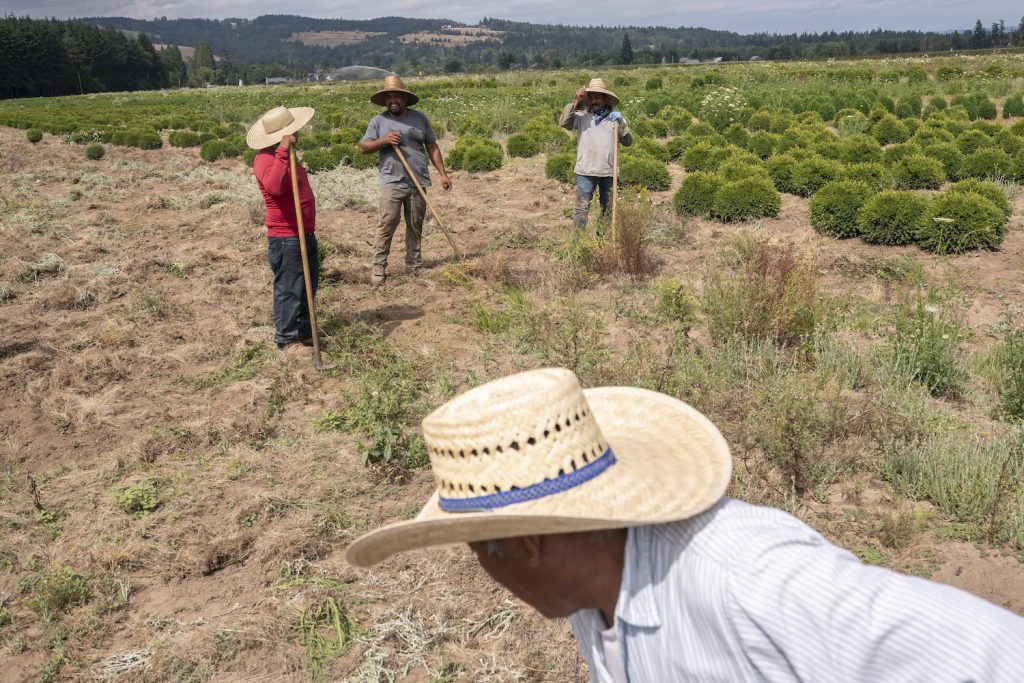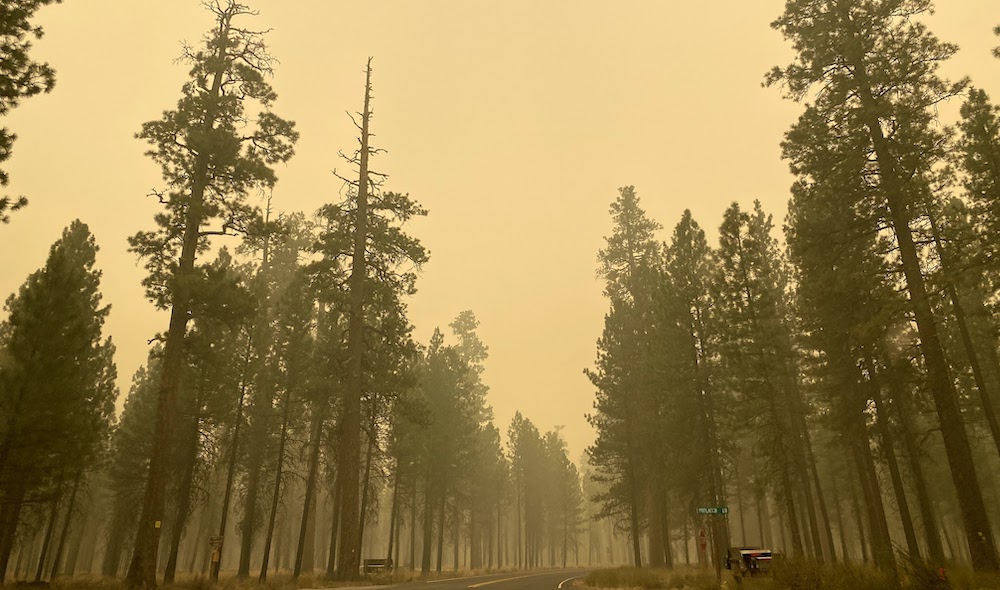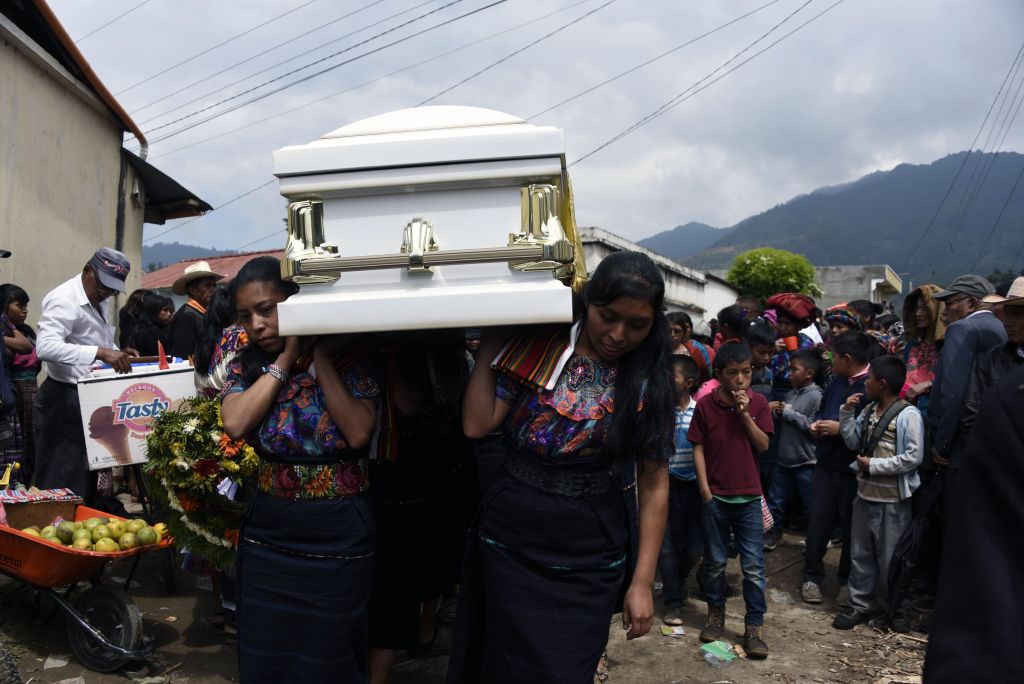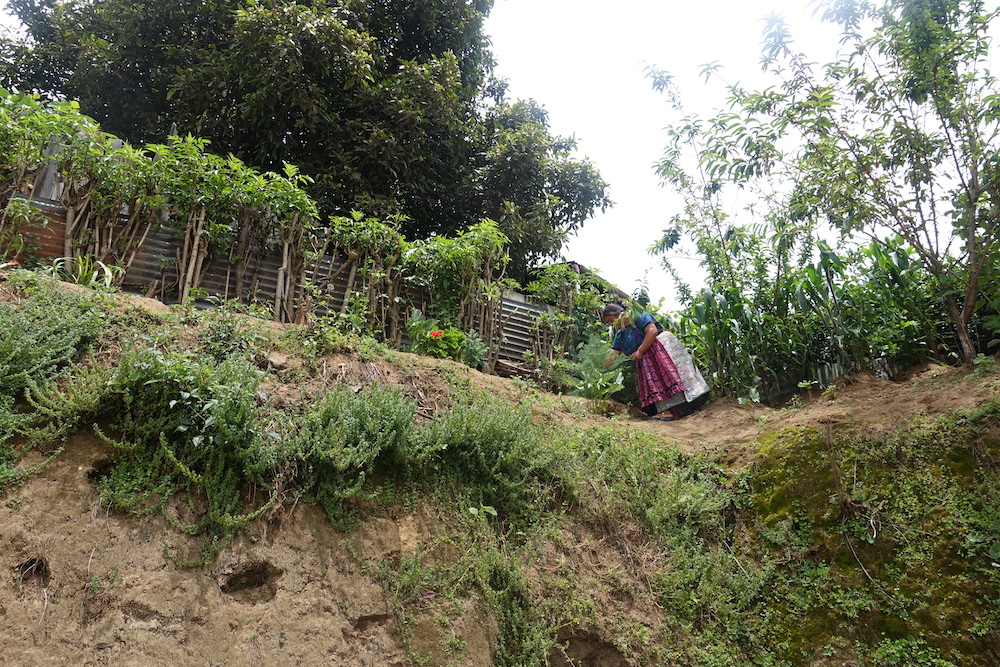Climate Migrants Are on the Move—And the U.S. Needs Their Help

Content Warning: The materials presented below contain details of racism and violent death.
I write from a small community in Central Oregon, surrounded by dense forest on all sides. Rubber boots and rain gear are icons of the Pacific Northwest, but it has barely rained this year, one of the driest and hottest on record.
We live among ponderosa pines that are several hundred years old. My 6-year-old recently suggested that we photograph them because he is afraid, for good reason, that they won’t last through summer. Not far south, the Bootleg Fire burned 413,000 acres this summer, spreading smoke across the continental United States. Last September, an inferno near our house incinerated 130,000 acres overnight, blanketing our community with toxic smoke for weeks. My family scoured maps of the western U.S. looking for where the air was breathable, only to realize there was nowhere safe to run.
The feeling of being out of options is one I’ve encountered often in my fieldwork. As an anthropologist, I’ve spent more than 20 years regularly traveling to Guatemala, spending time with people who have lived for years without a safe haven. Climatic catastrophes have ravaged communities in the country’s Western Highlands, spurring a climate migration: the mass movement of people from increasingly uninhabitable homelands.
But when Guatemalans and other migrants seek refuge in the United States, they are routinely turned away. Over the past year during the pandemic, the U.S. closed its asylum system, and more than 1.3 million people now face deportation in the court system.
These border walls have not made the U.S. safer. Instead, they have kept many people in the U.S. focused on the myth of their own exceptional superiority and advancement, even as their rivers run dry and their forests catch fire. Hundreds of people died in June’s record-breaking heat wave in the Pacific Northwest. The entire country is now gripped by cascading crises of drought, hurricanes, and floods.
The U.S. needs to open its borders—not only to provide refuge to people grappling with climate-related vulnerability, but because we need the help too. For too long, border walls have prevented many people in the U.S. from learning about other ways of living—including less harmful techniques of forestry and water management.
To survive what’s coming, we also need to be open to radical changes in our ways of life that can help us build new networks of solidarity.
Several women from the small communities where I work in Guatemala have recently died crossing into the U.S. A U.S. Border Patrol guard shot 20-year-old Claudia Gómez González in the head shortly after she crossed into Texas in 2018. In 2019, her neighbor, Victoria Méndez Carreto, also 20, died of dehydration in the desert of Arizona. In 2020, 19-year-old Miriam Estefany Girón Luna, from the same mountain range as Claudia and Victoria, fell from the U.S.-Mexico border wall while crossing. Treated as a criminal before she was treated as a patient, she was 30 weeks pregnant when she died.
Everyone leaving Guatemala knows that migration is deadly, and still people travel north. The Pew Research Center reports that the number of foreign-born Guatemalans living in the U.S. has increased 171 percent over the past 20 years, from 319,000 in 2000 to 864,000 at the last count in 2017. Only 27 percent of foreign-born Guatemalans in the U.S. are U.S. citizens, which means that most live in extremely precarious conditions.
In June, Vice President Kamala Harris flew to Guatemala to deliver a message to those who are considering fleeing to the U.S.: “Do not come. The United States will continue to enforce our laws and secure our border.”
The U.S. government should spare Guatemalans the lecture. For decades, the U.S. has engaged in international policies meant to destabilize this Central American country. From March to September of last year, the government deported thousands of people to Guatemala—331 of whom had active COVID-19 infections—despite ample evidence that this would only drive rates of migration up.
“Do not come” is not actually directed at Guatemalans, and it is not really meant to keep migrants away. Instead, the message is directed at businesses in the United States: Don’t be obliged to treat Guatemalans with care.
Harris’ blunt statement builds on longtime “prevention through deterrence” policies put in place in 1994 during Bill Clinton’s presidency. Fueling what Cristina Beltrán, a political scientist at New York University, calls “anti-migrant nativism,” these messages fit hand in glove with U.S. migration policies, which are designed to create a non-White underclass—a pool of cheap, disposable laborers who are forced into invisibility and denied basic protections and rights.
These disparities, justified and perpetuated by white supremacist ideas, are only deepening with global warming. Earlier this month in Oregon, Sebastian Francisco Perez, a 38-year old Guatemalan farmworker, died in the 115 degree temperatures while moving irrigation lines for his employer. No heat regulations protected him, and migrant farmworkers risk losing their jobs if they advocate for themselves.
Meanwhile, White conservatives on my community’s social media pages lament that local businesses are understaffed while the U.S. border is “overrun” by “lazy illegals.” Emboldened by white nationalist political leaders, they cite the “rule of law” to excuse migrant deaths, indifferent to how the U.S. has violated national and international laws by closing asylum proceedings.
Even as unprecedented wildfires rage across the state, conservative commenters defend their freedom to “live free” from environmental regulations. Bumper stickers openly call for the rape and death of Governor Kate Brown, who recently issued an executive order on climate action. State Republicans, for their part, have worked to thwart legislation addressing climate change. Meanwhile, the local history museum, which pays homage to settler colonialism, says nothing about how Kiksht-, Numu-, and Ichishkíin-speaking peoples, whose descendants are today part of the Warm Springs Confederated Tribe, and other Indigenous groups implemented sophisticated fire-wise practices for centuries.
The cruelty that white nationalism authorizes not only harms migrants such as Claudia, Victoria, and Miriam Estefany, it also harms people already living in the U.S.
No one railing against migrants on the community social media pages ever shows interest in the migrants’ homelands but let me tell you about the birthplace of Claudia, Victoria, and Miriam Estefany.
They were from the state of Quetzaltenango, an ancestral homeland of Mam and K’iche’ people that remains majority Indigenous today. Many staple crops that today help feed the world—maize, peppers, and squash—were first domesticated around the area, aided by sophisticated irrigation and transportation systems.
“Guatemalans practically invented the lexicon of sustainability,” one scientist in Guatemala told me. For thousands of years, communities in the region have engaged in forest gardening and regenerative agricultural practices, but it wasn’t only technological inventiveness that contributed to this sustainability. Also crucial was a broader attention to the interdependence between humans, land, water, and skies.
A midwife from Claudia and Victoria’s community explained to me how her grandparents had taught her to sow corn by reading the moisture in the air—a skill she had honed over six decades. Today, however, climate patterns have come undone, and she no longer knows when to plant for a successful harvest. Unpredictable winds and weather systems have upended the seasons, bringing with them a dangerous cycle of flooding and drought.
The catastrophes unfolding are not principally caused by wind and weather, but by a climate of cruelty.
Last year, Guatemala was pounded by two successive hurricanes, causing mountains to suddenly liquify under the weight of rain, burying members of Indigenous communities alive. Then, within weeks, the land became dry as bone. Soils where people grew maize for millennia have turned to deserts.
Mutual aid networks immediately stepped up in the government’s absence to help, but they haven’t been enough. An estimated 3.5 million Guatemalans are currently experiencing emergency levels of food insecurity, according to a global food security classification system. The number of cases of acute malnutrition among children under 5 reported each year has been growing steadily worse, with nearly 20,000 cases reported so far this year alone. Many of these children are born to farmers with deep wisdom about how to grow food in challenging conditions.
These climate-related catastrophes follow on a long history of exploitation that has made these communities vulnerable and impoverished. A hundred years ago, police rounded up farmers from Claudia, Victoria, and Miriam Estefany’s communities and sent them to plantations where many died of illness, exhaustion, and hunger. The largest owner of the plantations, the United Fruit Company, held by U.S. interests, at one point controlled over 42 percent of Guatemala’s land. Men who grew crops to feed their families were forced by anti-vagrancy laws to work outside their traditional roles, splintering their way of life. Forcing them into employment also forced them to be hungry and poor, turning community-supported agriculture into a crime while conveniently supplying plantations with an abundant supply of cheap labor.
Guatemala’s recent wave of starvation is also the result of policy and trade decisions that have drastically affected the price of staple foods. Meanwhile, the U.S. has the highest cumulative CO2 emissions in the world since 1750 but refuses accountability for the climate disaster it has helped create for other countries.
Most land in Guatemala is not naturally uninhabitable. It has been made unlivable by political actions that treat poor and Indigenous lives as disposable. The catastrophes unfolding are not principally caused by wind and weather, but by a climate of cruelty.
Border violence, likewise, is not an accident. It’s meticulously engineered for the good of corporate and political interests, who have sought to force migrants into untenable, dangerous terrain—thereby stoking fear in potential migrants and maintaining control over labor markets and people’s lives.
Global warming serves as a clarion call to address environmental justice and racial justice together. One way we can do that is by refusing the violence of white nationalism and opening U.S. borders.
Some may find the call to open borders extreme or unrealistic, but the climate crisis demands unprecedented change. Border walls will not protect us from a heating planet. For humanity to flourish, we must reimagine our homelands as collective and our communities as interdependent. Opening borders is a vital step toward replacing a climate of cruelty with a climate that can nourish us all.
A few weeks before flying to Guatemala, Harris gave an impassioned speech that hailed the role of Indigenous knowledge in the fight against a warming planet:
“The communities hardest hit by climate change are the same communities harmed by wealth and gender inequality, toxic air pollution, and so much more. This truth holds around the world. I urge all of us to focus on these communities, including Indigenous communities, and consider their insight and experience in our efforts moving forward. They are critical leaders in this fight.”
Harris’ order to Guatemalans to “stay home” weeks later suggests that she did not mean what she said. Still, she was right. The plight of Indigenous communities in Guatemala is not just a harbinger of climate catastrophe yet to come. Guatemalans also hold valuable skills and insights for how to rebuild a world out of the wreckage and destruction of white supremacy—insights and skills that we in the U.S. desperately need if we want to improvise new ways of living together based on solidarity and care.
The United States should be throwing its borders open. We should be mercifully asking for help to reimagine our future and act in ways that will bring about full and meaningful change. Instead of “don’t come,” we should be saying the opposite:
“Come. We need help. Please come.”




























